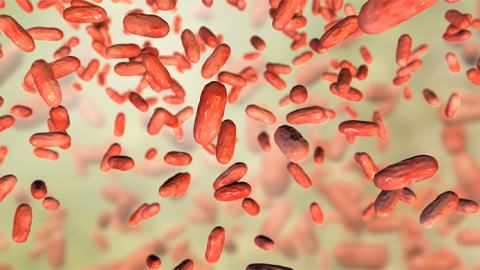Researchers uncover key biomolecule involved in whooping cough infection
Researchers have identified a new complex-carbohydrate biomolecule, or glycan, that plays a key role in the nasal colonization of the Bordetella bacteria responsible for whooping cough. The discovery could make it possible to create a new drug or vaccine that interferes with the glycan to greatly reduce or even stop ongoing Bordetella transmission.
Bordetella pertussis is the cause of the respiratory infection pertussis, which is widely known as whooping cough. Today’s pertussis vaccines keep people from getting severely sick, but they don’t eliminate the bacteria because it excels at colonizing, growing and persisting inside the nose. This means that despite more than 99% of people being vaccinated in the U.S., whooping cough continues to spread, leading to infections among vulnerable populations, particularly infants and elderly people.

Yang Su led the study at the University of Georgia in Athens.
“Our newly discovered glycan is crucial for the bacteria to maintain its ability to efficiently colonize the nose and transmit to a new host,” said Su, a doctoral candidate in the department of biochemistry and molecular biology. “By understanding the biochemical and molecular function of genes and enzymes involved in its formation, we can now intervene in the production of this glycan.”
Su will present the research at Discover BMB, the annual meeting of the American Society for Biochemistry and Molecular Biology, which will be held March 23–26 in San Antonio. He is co-advised by Maor Bar-Peled and Eric T. Harvill, both from the University of Georgia, and collaborates with Andrew Preston from the University of Bath in the UK and Thomas M. Krunkosky from the University of Georgia.
“My multidisciplinary approach integrates enzymology, glycan structural analyses, genetics, airway cell models and mouse infection models,” said Su. “To my knowledge, this is the first report of a glycan that is significant for the early colonization in the nose of its host.”
Glycans are biomolecules made of chains of carbohydrates such as polysaccharides. They are essential in various biological processes, including cell–cell recognition, signaling and immune response modulation.
In a previous study, the researchers discovered that a glycan known as transmission extracellular polysaccharide (tEPS) was required for Bordetella to spread among hosts. They then discovered that the production of tEPS glycan was related to another group of genes. The investigators suspected that this new group of genes likely produced another glycan, but nothing was known about its function or structure.
In the new work, the researchers eliminated the genes that expressed this unknown glycan frombacteria to see if they could uncover its function. The resulting Bordetella mutant showed a 70% reduction in its ability to colonize the nose of mice within six hours of inoculation. The mutant also showed a significantly reduced ability to transmit from the original host to a new host.
The researchers discovered that this new glycan, which they named bordetellea colonization oligosaccharide, or b-Cool, is found in multiple Bordetella species, including those infecting dogs and other animals, as well as in strains of Bordetella pertussis isolated from patients. This suggests that targeting b-Cool could lead to the development of vaccines and medications that would be effective against both animal and human infections.
The researchers are now working to understand how b-Cool mediates Bordetella colonization in the nose, information that will help develop therapeutics that interfere with colonization. They are also developing a vaccine that targets the b-Cool glycan, which they plan to test in various hosts.
Yang Su will present this research during a poster session from 4:30 to 6:30 p.m. CDT on Monday, March 25, in the exhibit hall of the Henry B. González Convention Center (Poster Board No. 288) (abstract).
Enjoy reading ASBMB Today?
Become a member to receive the print edition four times a year and the digital edition monthly.
Learn moreGet the latest from ASBMB Today
Enter your email address, and we’ll send you a weekly email with recent articles, interviews and more.
Latest in Science
Science highlights or most popular articles

Mapping fentanyl’s cellular footprint
Using a new imaging method, researchers at State University of New York at Buffalo traced fentanyl’s effects inside brain immune cells, revealing how the drug alters lipid droplets, pointing to new paths for addiction diagnostics.

Designing life’s building blocks with AI
Tanja Kortemme, a professor at the University of California, San Francisco, will discuss her research using computational biology to engineer proteins at the 2026 ASBMB Annual Meeting.

Cholesterol as a novel biomarker for Fragile X syndrome
Researchers in Quebec identified lower levels of a brain cholesterol metabolite, 24-hydroxycholesterol, in patients with fragile X syndrome, a finding that could provide a simple blood-based biomarker for understanding and managing the condition.

How lipid metabolism shapes sperm development
Researchers at Hokkaido University identify the enzyme behind a key lipid in sperm development. The findings reveal how seminolipids shape sperm formation and may inform future diagnostics and treatments for male infertility.

Mass spec method captures proteins in native membranes
Yale scientists developed a mass spec protocol that keeps proteins in their native environment, detects intact protein complexes and tracks drug binding, offering a clearer view of membrane biology.

Laser-assisted cryoEM method preserves protein structure
University of Wisconsin–Madison researchers devised a method that prevents protein compaction during cryoEM prep, restoring natural structure for mass spec studies. The approach could expand high-resolution imaging to more complex protein systems.

